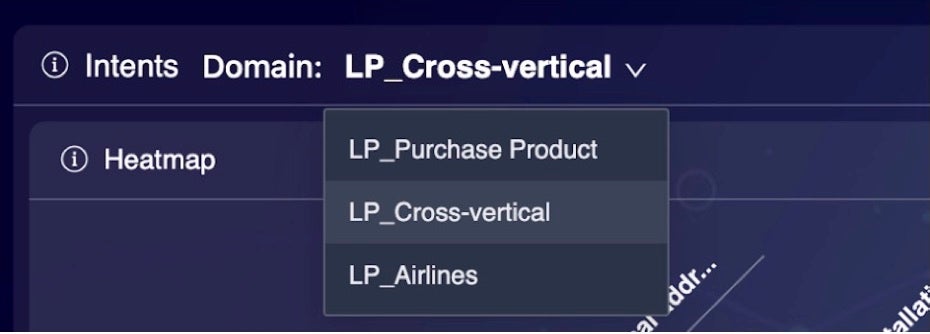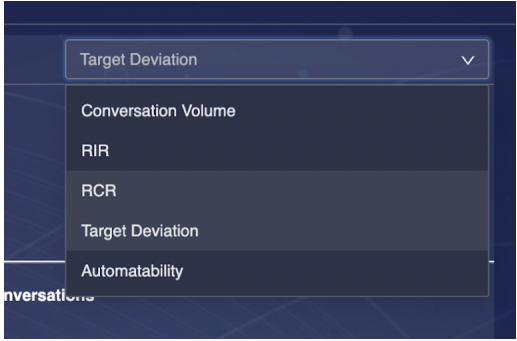Week of June 29
Support for Intent Manager, Performance Optimizer, Medallia COnversations, and Third-party bots
Features
Repeat Intent Rate Metric
Enhancements
Repeat Intent Rate Metric - Intent Manager & Performance Optimizer)
Operations leaders have always used resolution and repeat contacts to gauge level of effectiveness. When a consumer returns because their intent wasn’t resolved, total conversation volume increases, additional load is placed on agents, and consumer satisfaction is likely to decrease. Repeat Contact Rate (RCR 3 Day) is a measure of consumers who return within 3 days for any reason.
At the intent level, Repeat Intent rate helps brands understand if consumers coming back for the same intent or a different reason. Repeat intents are typically an undesirable outcome in a care operation, but they may signal positive steps toward conversion in a sales operation if the intent has changed. With the right context, , operation leaders can quickly target the right conversations and expedite the implementation of optimization plans.
Example
- On Day 0, 12 consumers message with my brand.
- On Day 0, 8 consumers message about the “pay my bill” intent.
- Within the next 3 days, 4 of the 12 consumers return to message about any intent.
- Within the next 3 days, 2 of the 8 “pay my bill” consumers return to message about any intent.
- Within the next 3 days, 1 of the 8 “pay my bill” consumers return to message about “pay my bill”.
- Repeat Contact Rate (RCR) = 4/12 = 33%
- Repeat Contact Rate for “Pay My Bill” Intent = 2/8 = 25%
- Repeat Intent Rate (RIR) = 1/8 = 13%
Product Visibility of Repeat Intent Rate
Users are able to view Repeat Intent Rate '3 Day' metric and graphs within Intent Manager on the Intent Analyzer tab and within the Intent Heatmap in Performance Optimizer:
Intent Manager displays the metric within the Analyze tab of Intent Manager and allows the user to view the metric by intent distribution and trends, which is consistent with the other metrics on this tab.
Performance Optimizer will display Repeat Contact '3 Day' within the Intent Heatmap allowing the user to simultaneously compare intent volume by RIR '3 Day', RCR '3 Day', MCS, and average agent response volumes.
Prerequisites & Enablement
- Build your intent taxonomy (Getting Started with Intents).
- Enable the metric within Chart Display settings of Widget for Intent Manager to display on your dashboards.
Features
Performance Optimizer introduces domain selection, repeat intent rate and repeat contact rate and additional sorting capabilities.
Enhancements
Intent Domain Setting
Users can view Intent Heatmap data for specific Intent Domains as they have been defined within Intent Manager. The domain options are available in a drop down menu on the upper left corner of the Intent Heatmap. Clicking on the drop down box exposes all intent domains as they appear within Intent Manager. The default domain setting in the Performance Optimizer heatmap is the same as in Intent Manager.

Select the intent domain to display data specific to the selection.
Heatmap Sorting Enhancements
Users have the ability to sort data within the heatmap based on the 5 options below. Each sort option updates the intents displayed based upon the sort option in a descending order from left to right. The intent heatmap will only display the top 10 intents based on volume regardless of sort selection. Conversation volume is the default sort option.
- Conversation Volume
- Repeat Intent Rate
- Repeat Contact Rate
- Benchmark Deviation
- Automatability

performance optimizer heatmap
Repeat Intent Rate & Repeat Contact Rate Metrics
The repeat intent rate and repeat contact rates have been added to the Intent Heatmap. Using these metrics, users are able to prioritize intents in order to drive operational effectiveness. Users can compare these metrics against volume, customer satisfaction, and agent conversation volume in order to isolate those intents that should be investigated within Intent Manager.
Features
Medallia - Survey trigger based on conversation interactiveness
Sending surveys to consumers who aren’t interacting with your brand can negatively impact your CSAT score without cause. You can now enable this setting to send surveys only to engaged consumers. Specify the min number of messages that must be sent by the bot/human agent and by the consumer for the survey to be triggered. This is available in the Medallia Survey setup experience via iHub.

Medallia - Survey trigger based on conversation interactiveness
Features
Amazon Lex v2 support
Brands can create third-party bots connected to Amazon's LexV2 vendor. LexV2 offers an opener developer experience and enables a single bot to use multiple languages by using a locale Id for identification.
Support for ManualETTR
It is possible to set a Time to Resolution (TTR) setting on a conversation, to set an expectation for a human agent in what timeframe they need to answer a conversation. In addition to the three predefined types of TTR changes in Third-Party Bots ('Urgent', 'Prioritized', and 'Normal'), there is now 'Manual' as an additional TTR Type, to provide a more customizable experience. The manual type needs to be sent within a number value and a unit (SECONDS; MINUTES; HOURS). With this, the TTR can be set to a specific time in the future and not only to predefined values.
Fixes
Chat message combiner fix
Bots can now send the correct customer response to the vendor and not unnecessarily combine. Previously, when a chat bot is configured with message combine enabled, it received an ‘undefined’ prefix on every message that the customer response was triggered by an action button, preventing the vendor from using the correct utterance on such interactions. (This occurred because on triggered action buttons two events, one with the message and one with the action status event, were received.)
Correct intent displayed for knowledge base responses under Bot Escalation Summary
Watson Bot with Discovery Search enabled can now find a correct matching knowledge base article and the static value ‘knowledge base’ is defined. Previously, the bot escalation summary showed a wrong intent in the Bot Escalation Summary.